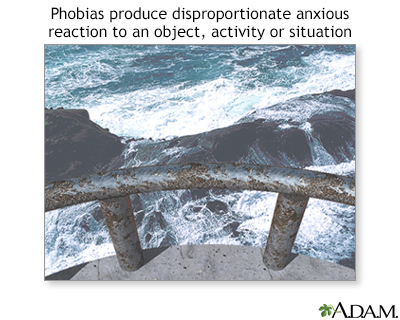
Anxiety disorder - phobia
A phobia is an ongoing intense fear or anxiety of a certain object, animal, activity, or setting that poses little to no actual danger.

Specific phobias are a type of anxiety disorder in which a person may feel extremely anxious or has a panic attack when exposed to the object of fear. Specific phobias are a common mental disorder.
Common phobias include the fear of:
Being exposed to the feared object or even thinking about being exposed to it causes an anxiety reaction.
You avoid settings in which you may come into contact with the feared object or animal. For example, you may avoid driving through tunnels, if tunnels are your phobia. This type of avoidance can interfere with your job and social life.
Your health care provider will ask about your history of phobia, and will get a description of the behavior from you, your family, or friends.
The goal of treatment is to help you live your daily life without being impaired by your fears. The success of the treatment usually depends on how severe your phobia is.
Talk therapy is often tried first. This may involve any of the following:
Certain medicines, often also used to treat depression, may be very helpful for this disorder. They work by preventing your symptoms or making them less severe. You must take these medicines every day. Do not stop taking them without talking with your provider.
Medicines called sedatives (or hypnotics) may also be prescribed.
If you are prescribed a sedative, do not drink alcohol while on this medicine. Other measures that can reduce the number of attacks include:
Phobias tend to be ongoing, but they can respond to treatment.
Some phobias may affect job performance or social functioning. Some anti-anxiety medicines used to treat phobias may cause physical dependence.
Contact your provider for an appointment if a phobia is interfering with life activities.
American Psychiatric Association website. Anxiety disorders. Diagnostic and Statistical Manual of Mental Disorders. 5th ed. Text Revision (DSM-5-TR), Washington, DC: American Psychiatric Association Publishing; 2022.
Baker AW, Dekel S, Jagodnik KM, Pace-Schott EF, Post LM, Orr SP. Anxiety disorders and post-traumatic stress disorder. In: Stern TA, Wilens TE, Fava M, eds. Massachusetts General Hospital Comprehensive Clinical Psychiatry. 3rd ed. Philadelphia, PA: Elsevier; 2025:chap 31.
Lyness JM, Lee HB. Psychiatric disorders in medical practice. In: Goldman L, Cooney KA, eds. Goldman-Cecil Medicine. 27th ed. Philadelphia, PA: Elsevier; 2024:chap 362.
National Institute of Mental Health website. Anxiety disorders. www.nimh.nih.gov/health/topics/anxiety-disorders. Last Reviewed April 2024. Accessed May 30, 2024.
BACK TO TOPReview Date: 5/4/2024
Reviewed By: Fred K. Berger, MD, addiction and forensic psychiatrist, Scripps Memorial Hospital, La Jolla, CA. Also reviewed by David C. Dugdale, MD, Medical Director, Brenda Conaway, Editorial Director, and the A.D.A.M. Editorial team.

|
A.D.A.M., Inc. is accredited by URAC, also known as the American Accreditation HealthCare Commission (www.urac.org). URAC's accreditation program is an independent audit to verify that A.D.A.M. follows rigorous standards of quality and accountability. A.D.A.M. is among the first to achieve this important distinction for online health information and services. Learn more about A.D.A.M.'s editorial policy, editorial process and privacy policy. A.D.A.M. is also a founding member of Hi-Ethics and subscribes to the principles of the Health on the Net Foundation (www.hon.ch). |
The information provided herein should not be used during any medical emergency or for the diagnosis or treatment of any medical condition. A licensed medical professional should be consulted for diagnosis and treatment of any and all medical conditions. Call 911 for all medical emergencies. Links to other sites are provided for information only -- they do not constitute endorsements of those other sites. © 1997- A.D.A.M., Inc. Any duplication or distribution of the information contained herein is strictly prohibited.